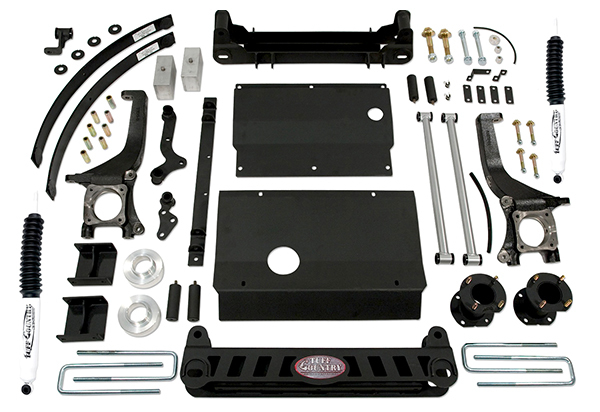 A majestic lifted truck gives off a certain vibe, and you want that vibe for your truck: a vibe of total control, of heightened perspective, of a towering above the other cars and trucks on the road. A lift kit by Fabtech or Ready Lift gives your truck's suspension additional ground clearance, useful when mudding and tooling around off-road, but the crux of the issue comes down to size. Bigger is better. You know this, and everybody else does, too.
A majestic lifted truck gives off a certain vibe, and you want that vibe for your truck: a vibe of total control, of heightened perspective, of a towering above the other cars and trucks on the road. A lift kit by Fabtech or Ready Lift gives your truck's suspension additional ground clearance, useful when mudding and tooling around off-road, but the crux of the issue comes down to size. Bigger is better. You know this, and everybody else does, too.
Attaching a sturdy lift kit is not easy. You will need a jack or hoist for your frame, and another jack for your axels. The job will require you to remove tires, deal with ceased and rusted bolts, hammer and punch at stiff joints and use lots of grease. When finished, however, when your truck sits up high and the concerns of the normal-sized and low-riders among you are no longer yours, you will be able to look back and say, "I did this. I made my truck this way." That feeling alone will pay for the effort, though you'll also save time and money by skipping the mechanic.
For this job, you will need the full compliment of tools available to you, and then some. Mallets, screwdrivers, wrenchs, socket wrenches, air tools, and power drills, to name a few. The following instructions are intended to give you some idea of how the process goes, but as with most mechanical jobs, each individual application will provide challenges and opportunities unique to it specifically.
How to Install a Lift Kit
Please note:It is of the utmost importance throughout this process that you tighten everything to manufacturer's recommendations. Use a torque wrench to apply the appropriate amount of torque to all bolts.
- To begin this process, lift your vehicle via a jack or hoist stationed underneath your truck's frame. If using a floor jack, you will also need to place a jack beneath the axel on which you intend to start. Augmenting your jacks with pieces of wood, cradles, or ramps to add height and prevent slipping is recommended.
- Open your new lift kit's packaging and ensure that everything that is supposed to be included is accounted for. In addition to reviewing the hardware, consult the directions and make sure you have all the tools you will need to complete this job. If you do not have what you need, buy or borrow the proper tools before beginning. The single most important thing you can do to guarantee a successful installation is closely follow the instructions, including having every individual tool at the ready.
- It is generally thought to be a good idea to work your way from front to back. This being the case, remove the front tires once you have them jacked to the proper height. You should not attempt to remove your tires until they are fully clear from the ground and are no longer bearing any vehicle weight.
- Find and remove, in this order, your current shocks, U-bolts, and springs. You should have been able to find the replacements for each of these parts when you inventoried your hardware. Once removed, either trash them or set them out of the way, depending on what you plan to do with them later.
Helpful Hint:You may have to take certain liberties when removing your current suspension. Feel free to hammer out, cut off, or pry loose any bolts that stick or have rusted. Whatever you have to do to remove the old bolts is fine, because you are going to use new bolts when installing your new system. Just make sure that you don't do any damage to the mechanics of your vehicle itself. It is a good idea to grease the non-threaded sections of all bolts involved in your install, as well.
- Some assembly of your new springs may be required. At most, this will involve greasing your bushings or sleeves and hammering them into your springs. Once your new springs are ready, bolt them into place.
- Working backwards from how you took everything apart, next you will bolt in your U-bolts. Take special care to ensure your U-bolts are perfectly vertical, and be sure to properly align your spring and U-bolt pad so that everything connects the way it did before you took it apart.
- Assemble each individual shock. This will probably involve greasing and then hammering in the bushing and sleeve and attaching a boot of some sort. When your shock is fully assembled, install it. One note: be careful when releasing the shock as you install it. The shock will expand slowly, almost stretching out. Make sure that as it does, you fit it into place when it meets the top bolt to which it will attach. Trying to force the shock back into its tube by hand once released can be a pain, particularly if you've already bolted in the bottom portion.
- With the new system applied to your front two tires, you will need to replace the steering stabilization system. This will usually involve the stabilizer itself and a drop pitman arm. You may have to disconnect certain mechanisms to access your factory stabilizer. Once disconnected, install new brackets prior to fitting in your new stabilizer. Make sure that your stabilizer is properly positioned between those brackets as laid out in your kit's instructions before fully tightening it and installing your drop pitman arm.
- With the stabilizer and pitman arm both installed, the hard part is over. You will have to do neither when installing your rear wheels. Repeat Steps #4 through #7 on your rear axel, remembering to keep track of everything and bolt everything securely.
- When you have reattached all four wheels, lower your vehicle back onto solid ground. Go back through and retighten your new bolts and fasteners, bringing all of it to the manufacturer's recommended levels. It is then in your best interest to check everything again after driving 50 miles, and then 150 miles, and retightening those elements that need to be further tightened. Once the tightness is as it should be, what you choose to do with your newly lifted truck is completely up to you.
Conclusion
![]() Your lift kit will raise your truck's suspension to nearly indomitable heights. There isn't a mud pit or off-road course that will stand a chance against your new behemoth. It's not an easy job installing a lift kit yourself, but it is a rewarding one upon completion. For further help installing your lift kit, please don't hesitate to call our friendly and helpful Customer Service staff at 800-663-1570.
Your lift kit will raise your truck's suspension to nearly indomitable heights. There isn't a mud pit or off-road course that will stand a chance against your new behemoth. It's not an easy job installing a lift kit yourself, but it is a rewarding one upon completion. For further help installing your lift kit, please don't hesitate to call our friendly and helpful Customer Service staff at 800-663-1570.




